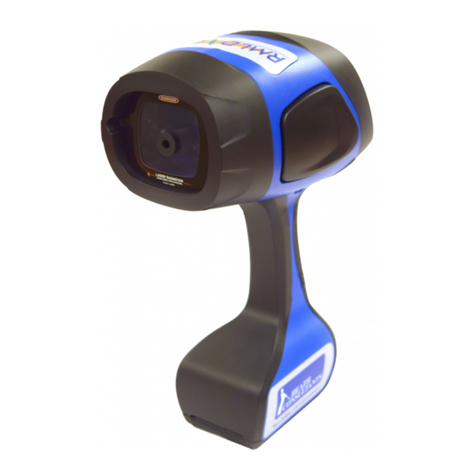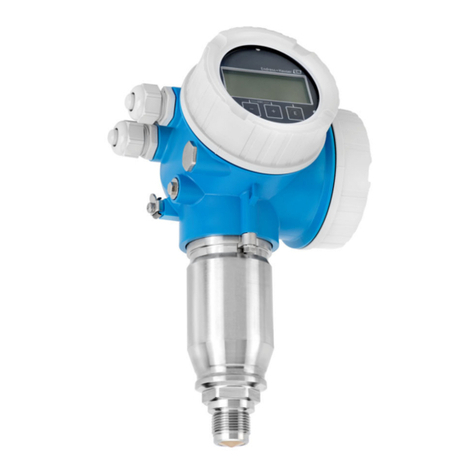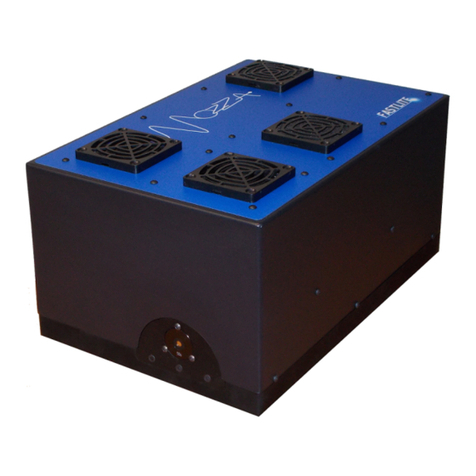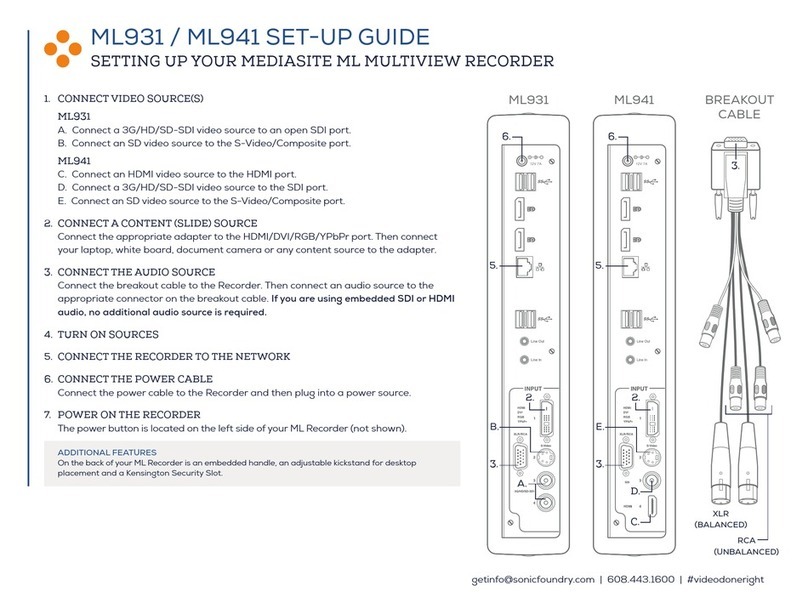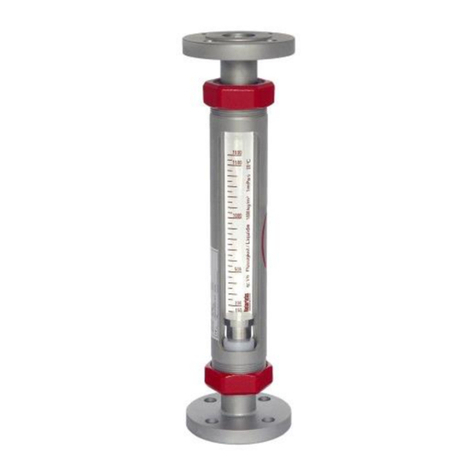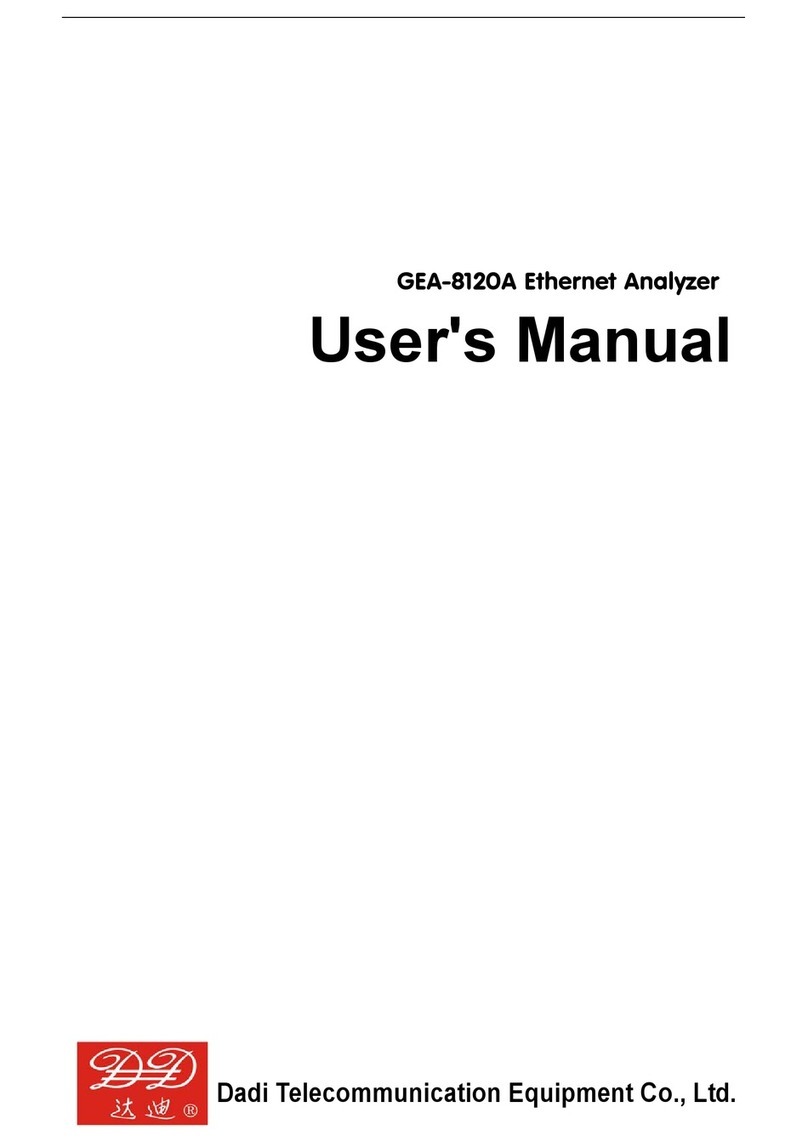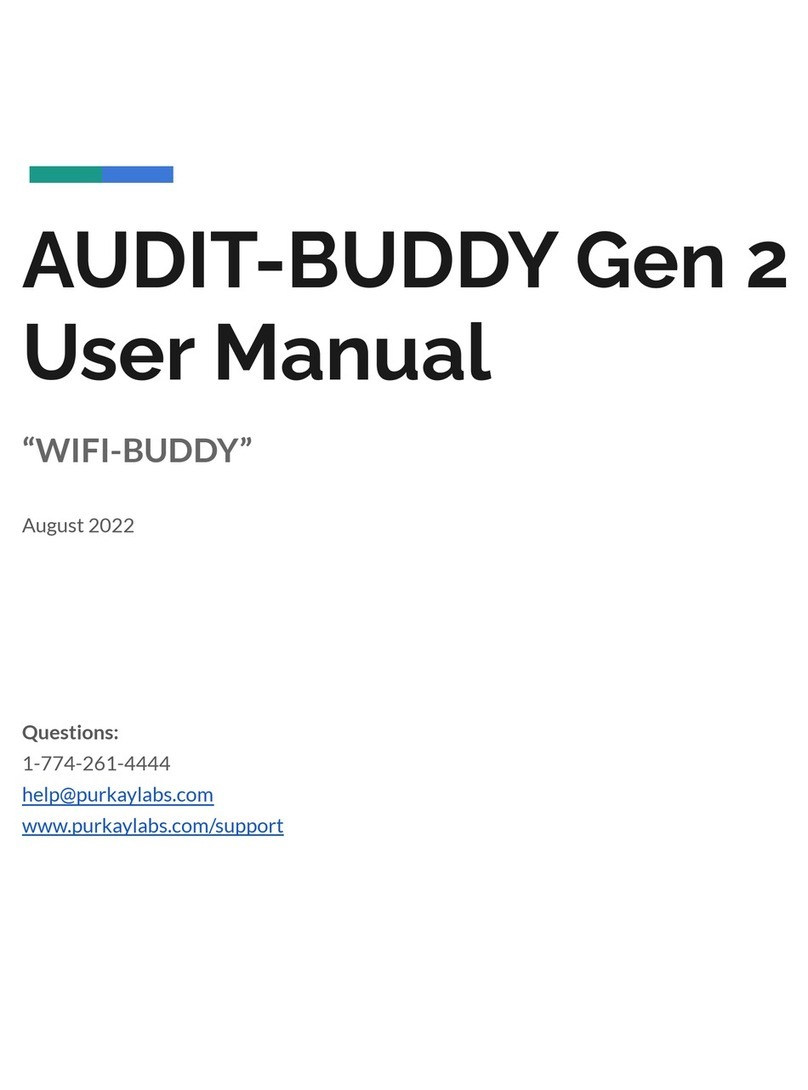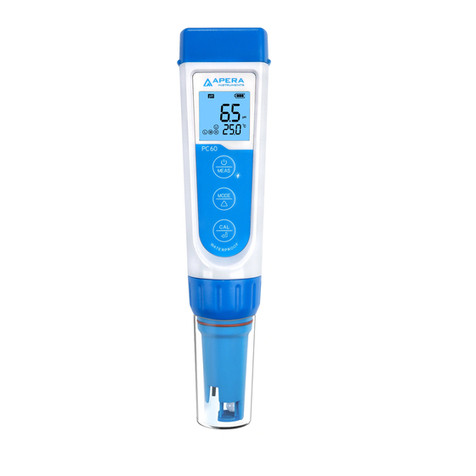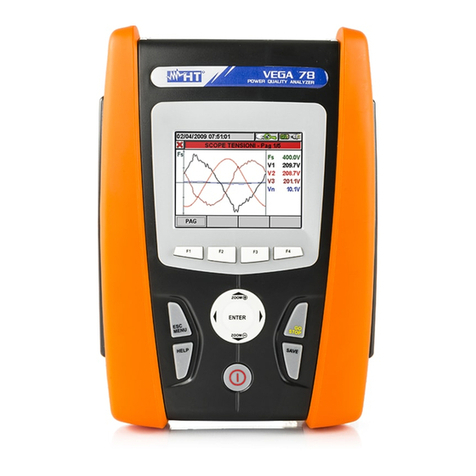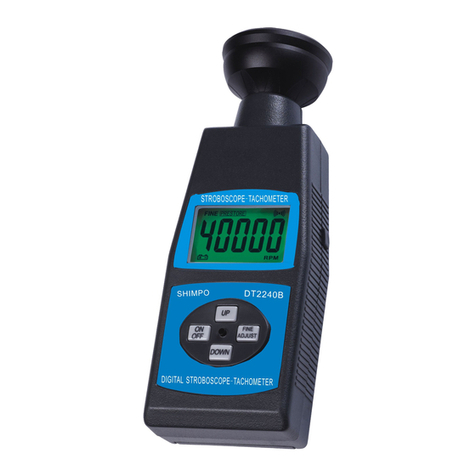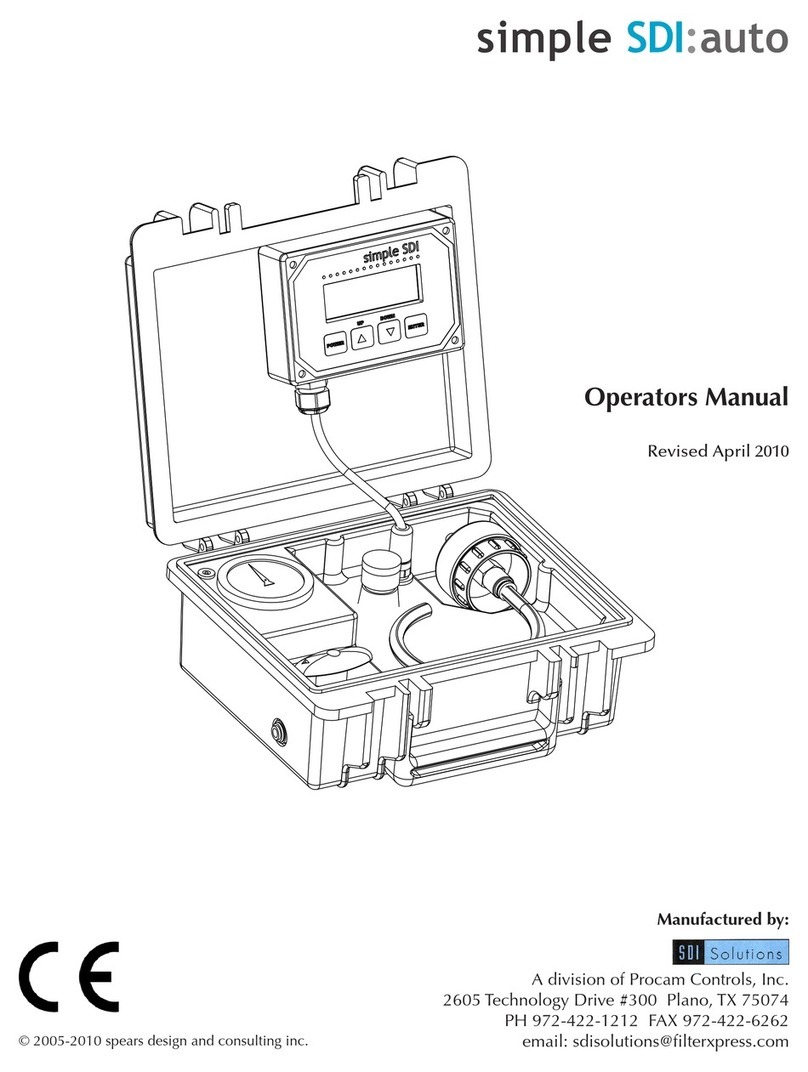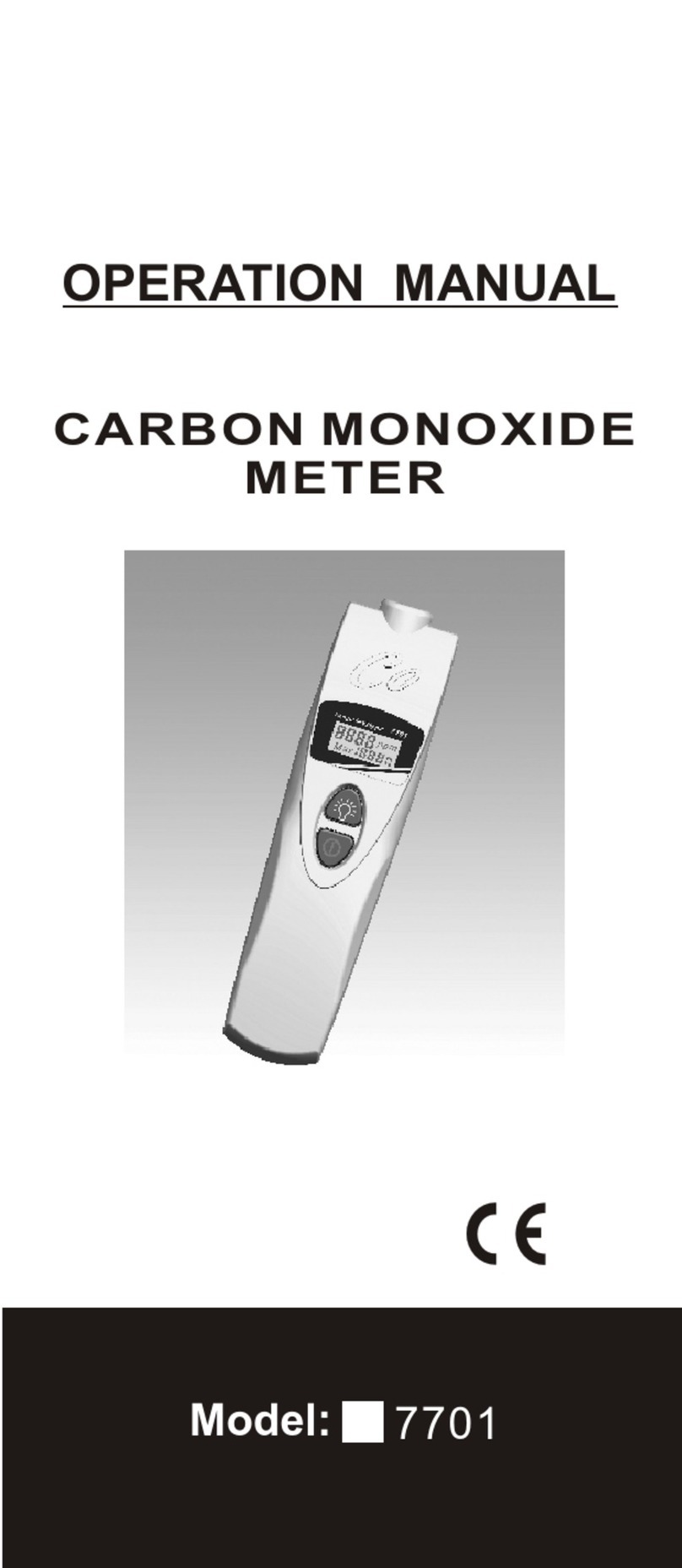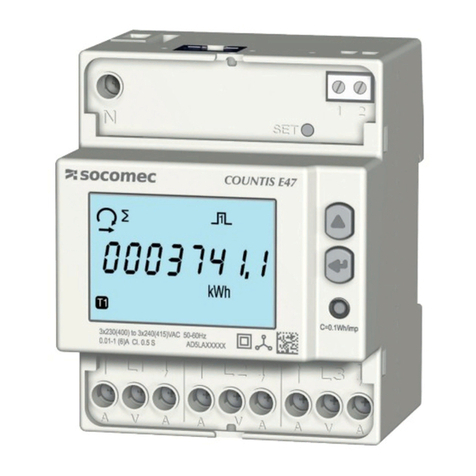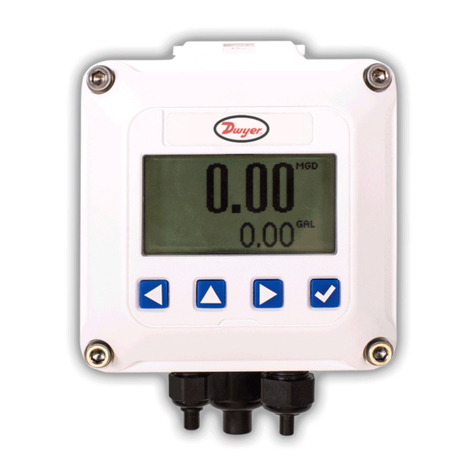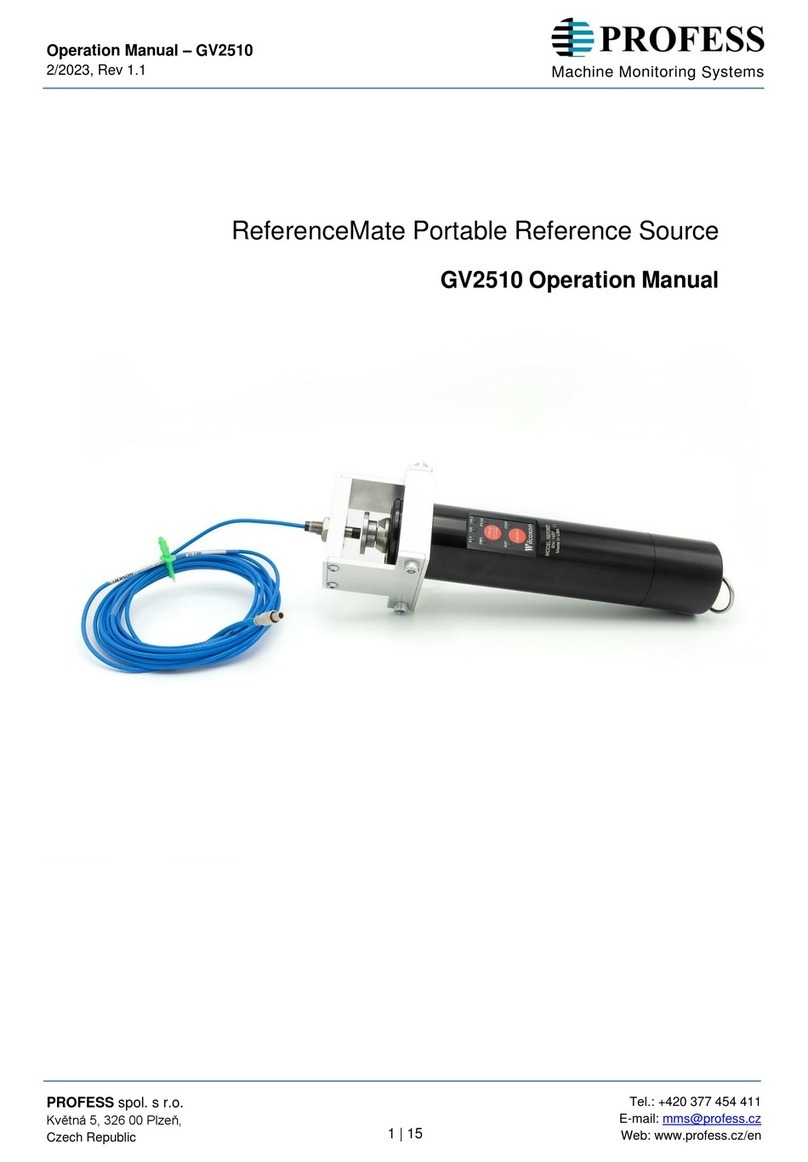Heath Consultants Odorator 2 User manual

ODORATOR 2TM
Operator’s Manual
All Models

Proprietary Notice
The contents of this instruction manual are proprietary to Heath Consultants Incorporated.
Reproduction of this manual, in whole or in part, is prohibited without the express written
consent of
Heath Consultants Incorporated.
Heath Consultants Incorporated operates under a continual
productimprovementprogramand
reservestherighttomakeimprovements and / or changes without prior notification.
This manual supersedes all previous manuals for this instrument.
COPYRIGHT 2015, HEATH CONSULTANTS INCORPORATED.
Operator’s Manual, ODORATOR 2, HPN: 104147 Rev. C
ODORATOR 2, Complete, HPN: 104175

Heath Consultants Incorporated
9030 Monroe Road
Houston, TX 77061
Tel: 713-844-1300
www.heathus.com
ODORATOR 2
Operator’s Manual
Models:
1.00 % Methane
0.50 % Methane
0.15 % Methane
0.44 % Propane

TABLE OF CONTENTS
Introduction …………………………………………………………….…………………………
1
Warnings and Cautions …………………………………………….……….…………………..
2
Product Specifications …………………………………………………………………………..
4
Use At Elevation ………………………………………………………………………………....
5
Use at Low Temperature Extremes …………………………………………………………….
5
List of Contents ………………………………………………………….…………………….…
5
Power On Sequence …………………………………………………………………………….
5
Test Mode Sequence ……………………………………………………………………………
6
CHAPTER ONE
Instructions for Operation …………………………………………………….………………...
7
Odor Threshold Level and Relative Odor Intensity Tests Procedure …………………
7
Bluetooth …………………………………………………………………………………….
10
ODORATOR 2 Operator Controls and Connectors …………………………………….
10
Figure 1. ODORATOR 2 Top Panel Layout …………………….……………….
10
Figure 2. ODORATOR 2 Rear Case View …………………….……….………..
11
Battery Charging ………………………………………………………………………..……….
11
Battery Pack Replacement ……………………………………………………………………..
12
CHAPTER TWO
Periodic Test ……………………………………………………………………………………..
13
Calibration ………………………………………………………………………………………...
13
CHAPTER THREE
Troubleshooting Chart …………………………………………………………………………..
14
Parts List ………………………………………………………………………………………….
14
Appendix A - Periodic Test Records …………………………………………………………..
15
CHAPTER FOUR
Warranty and Warranty Repair …………………………………………………………………
18
Return Procedure (RMA) ………………………………………………………………………..
19
Declaration of Conformity ……………………………………………………………………….
20
Sales, Customer Service and Instrument Repair Locations ………………………..……….
21
Notes ………………………………………………………………………………………………
23

1
Introduction
The ODORATOR 2 is a handheld, portable, electronic GNSS based audit system used to
evaluate and record the odor levels within a utility’s gas stream at actual test locations. Natural
gas (methane) and propane are two most common gases typically odorized and distributed.
Sample gas to be tested enters the ODORATOR 2 through the quick connect fitting at the gas
supply inlet port. Internally, the sample gas passes through an internal five-micron filter to the
input of a low-pressure regulator. It then passes from the output of the low-pressure regulator
to the flow metering valve. This valve, located on the top panel of the ODORATOR 2, is
controlled by the operator. After passing through the valve (when partially opened), the gas
enters a mass flow sensor. This is the heart of the ODORATOR 2. The mass flow sensor
responds to gas flow within the range of the flow metering valve. The signal from the mass flow
sensor is then converted to a digital signal, processed and fed to LCD display. Metered gas
from the mass flow sensor then passes to the mixing chamber where it is combined with fresh
air drawn in by a blower. The operator then sniffs the gas / air mixture at the exhaust port as
part of the test. If no odor is detected, the flow metering valve is incrementally opened, and the
exhaust port sniffed until odor is readily detectable at which time the operator presses the
READ switch to automatically record the corrected percent gas in air by volume, GNSS
location (GPS and/or GLONASS), test time & date and various instrument parameters. While
driving to the various test points in the distribution system the ODORATOR 2 may also
automatically record the GNSS location, date, time and various instrument parameters to be
able to show the actual breadcrumb trail used. The electronics and the speed of the blower are
calibrated so that the concentration of the gas / air sample at the exhaust port agrees with the
LCD reading at 20% of the Lower Explosive Level (LEL) or at a pre-determined point less than
20% of the LEL. For methane / natural gas and propane the LEL is typically 5.0% and 2.2%
respectively. All readings are automatically corrected for atmospheric pressure and
temperature via an embedded microcontroller and associated sensors. Depending on how
much flow metering valve is opened, the concentration of gas in air at the exhaust port will be
anywhere from zero up to approximately 2% for methane. An alarm and the display alert the
operator of instrument status, problems or high reading values.
INTRODUCTION
The ODORATOR 2 continuously monitors its health and operational status. Typical operational
checks include but are not limited to: blower speed, battery state-of-charge, GNSS, memory
card, communications buss, power supplies and calibration interval.
Included but not required for odor level testing is OdorSeer and OdorSeer Remote PC
software for managing the recorded data, mapping, report generation, instrument configuration
and remote data access. Connectivity interfaces include USB 2.0 and Bluetooth. Refer to the
OdorSeer / OdorSeer Remote manual for details.
A replaceable, rechargeable Li Ion battery pack is used to power the ODORATOR 2. An
external power supply is used to re-charge the battery pack. The ODORATOR 2 is designed
and intended to be used in accordance with the GPTC Guide For Gas Transmission And
Distribution Piping Systems (49 CFR) 192.625 Subpart L dated 10-1-13, the ASTM Standard
D 6273 –08 and NFPA 58 for performing odor threshold level and relative odor intensity tests.
Supply gas must be high quality natural gas (methane) or propane. Blended or mixed gases as
sometimes found during peak shaving cannot be tested using the ODORATOR 2.

2
2
2
Warnings and Cautions
Prior to use, the operator should read all warnings and cautions, instructions for
operation and maintenance requirements contained in this operator’s manual.
WARNING:
DO NOT USE THE ODORATOR 2 OR BREATHE IN GAS FROM SOURCES WHICH MAY
CONTAIN TOXIC LEVELS OF CHEMICALS SUCH AS HYDROGEN SULFIDE (H2S) AS IT
COULD BE HARMFUL TO HUMAN HEALTH AND SAFETY TO DO SO. SOURCES WHICH
MAY CONTAIN TOXIC LEVELS OF CHEMICALS INCLUDE BUT ARE NOT LIMITED TO
PRODUCTION SYSTEMS AND LANDFILLS.
WARNING:
IT IS THE SOLE RESPONSIBILITY OF THE PRODUCT PURCHASER/ OWNER TO ENSURE
THAT: (1) ALL OPERATORS OF THE
ODORATOR 2 READ, UNDERSTAND,AND COMPLYWITH
THE PRECAUTIONS, INSTRUCTIONS FOR OPERATION AND MAINTENANCE REQUIREMENTS
CONTAINED IN THIS MANUAL; (2) THE ODORATOR 2 IS ONLY USED IN A PROPER AND SAFE
MANNER; AND (3) WHILE USING THE ODORATOR 2, OPERATORS ARE NOT INHALING OR
SNIFFING DANGEROUS MATERIALS
THAT COULD CAUSE INJURY OR DEATH. IF THE
EQUIPMENT IS USED IN A MANNER NOT SPECIFIED BY THE USER’S MANUAL, THE PROTECTION
PROVIDED BY THE EQUIPMENT MAY BE IMPAIRED.
WARNING:
DURING OPERATION, KEEP THE ODORATOR 2 AWAY FROM OPEN FLAMES. INLET SUPPLY
PRESSURE SHOULD NOT EXCEED FOUR PSIG. INLET
PRESSURES MORE THAN FOUR
PSIG COULD RUPTURE THE LOW
-PRESSURE
REGULATOR DIAPHRAM, VENT THE GAS
OUT OF THE INSTRUMENTANDCAUSE INSTRUMENTFAILURE. THERECOMMENDED INLET
SUPPLY PRESSURE IS 7” WATER COLUMN.
WHEN OPERATING THE ODORATOR 2 YOU WILL BE WORKING WITH
FLAMMABLE
METHANE OR PROPANE GAS WHICH IS POTENTIALLY DANGEROUS IF NOT HANDLED
PROPERLY. METHANE GAS FROM A LECTURE BOTTLE
MAY BE ODORLESS, COLORLESS
AND IS EXPLOSIVE IN CONCENTRATIONS OF APPROXIMATELY 5.0 TO 15.0 PERCENT BY
VOLUME IN AIR. PROPANE’S EXPLOSIVE RANGE IS APPROXIMATELY 2.2 TO 9.6 PERCENT BY
VOLUME IN AIR.
PRIOR TO CONDUCTING TESTS, VERIFY THE ENVIRONMENT AND IMMEDIATE AREA DO NOT
CONTAIN ANY POSSIBLE IGNITION SOURCES.
WHEN NOT OPERATING THE ODORATOR 2, CLOSE ALL VALVES AND TURN THE ODORATOR 2
OFF. ANY TIME GAS IS BEING PASSED THROUGH THE ODORATOR 2 THE POWER MUST BE
TURNED ON. THIS WILL DILUTE THE GAS AT THE
EXHAUST PORTAND PREVENT POCKETS
OF CONCENTRATED GAS FROM ACCUMULATING.
100% LEL ISAPPROXIMATELYEQUALTO 5.0% METHANE OR 2..2% PROPANE GAS BY
VOLUME IN AIR. AS LONG AS A REFERENCE CGI READS SAFELY BELOW THE
LEL (20% LEL
OR LESS) YOU SHOULD NOT HAVE ANY PROBLEMS WITH A FLAMMABLE
MIXTURE
BUILDING UP.
ANYSUSPICIONOFAGAS LEAK BY UNEXPLAINED SOUND OROPERATION OF THE
ODORATOR 2 IS REASON TO IMMEDIATELY SHUT OFF THE GAS SUPPLY VALVESAND
THEN SEEK THE CAUSE.
IF INDOORS, DO NOT TURN THE ODORATOR 2 ON UNTIL A REFERENCE CGI INDICATES SAFE

3
ENVIRONMENT. LIKEWISE, ALLOW THE ODORATOR 2 TO PURGE FOR AT LEAST ONE
MINUTE AFTER A REFERENCE CGI ALSO INDICATES SAFE ENVIRONMENT.
DO NOT PERFORM TESTS IN CLOSED OR CONFINED SPACES FOR PERSONNEL SAFETY.
PERFORM ALL MAINTENANCE IN A LOCATION KNOWN TO BE NON-HAZARDOUS.
TO REDUCE THE RISK OF IGNITION OF A FLAMMABLE OR EXPLOSIVE ATMOSPHERE, THE
BATTERY PACK MUST BE CHANGED OR CHARGED ONLY IN A LOCATION KNOWN TO BE NON-
HAZARDOUS.
NO ATTEMPT SHOULD BE MADE TO REPAIR THE INSTRUMENT BY THE OPERATOR. SHOULD THE
INSTRUMENT NOT WORK PROPERLY OR INDICATE AN ERROR OR WARNING, REFER TO THE
TROUBLESHOOTING SECTION OF THIS MANUAL. DO NOT OPERATE THE INSTRUMENT TO SNIFF
HAZARDOUS GAS IF INSTRUMENT INDICATES ‘ERRxx’ (error).
SUBSTITUTION OF COMPONENTS MAY IMPAIR SAFETY. NO OPERATOR SERVICEABLE
COMPONENTS ARE CONTAINED WITHIN THE INSTRUMENT.
ONLY USE BATTERY PACK HPN 101311-0. ONLY USE THE POWER SUPPLY AND CORDS
PROVIDED WITH THE INSTRUMENT TO CHARGE THE BATTERY. REPLACEMENT OF CORDS BY
INADEQUATELY RATED CORDS CAN RESULT IN UNSAFE OPERATION. USING A DIFFERENT
POWER SUPPLY FOR CHARGING THE INSTRUMENT MAY ALSO RESULT IN DAMAGE TO THE
BATTERY AND THE INSTRUMENT.
TO REDUCE THE RISK OF IGNITION OF A FLAMMABLE OR EXPLOSIVE ATMOSPHERE, ANY CABLE
(POWER or USB) MUST ONLY BE CONNECTED IN A LOCATION KNOWN TO BE NON-HAZARDOUS.
DO NOT OBSTRUCT OR BLOCK THE
INTAKE OR EXHAUST PORTS.
CAUTION:
TESTS SHOULD NOT BE PERFORMED IN WINDY CONDITIONS, RAIN OR SNOW. THE ODORATOR2
LID SHOULD BE CLOSED AND LATCHED WHEN NOT IN USE.
CAUTION:
Do not store the gas sample hose in the case. The gas sample hose must “breathe” in fresh air to
lengthen its useful life and not contaminate the instrument. A mesh bag attached to the carrying
handle isincluded and recommended to be used for storage.
CAUTION:
Because of inherent limitations, liquid crystal displays should not be subjected to extremes
of temperature or humidity. If the instrument is exposed to a temperature below -20oF
(-29oC) or above 158oF (70oC), the liquid crystal display may temporarily cease to function
properly and in some cases, permanent damage may result. It
is therefore recommended
that the instrument not be subjected to extreme conditions such asa closed vehicle in direct
sunlight or continuous sub-freezingtemperatures.
The battery pack contains thermal protection and will internally disconnect at temperatures
above 122oF (50oC). Do not charge the battery pack at temperatures above 104oF (40oC).
WARNING:
Do not expose the battery pack to temperatures above 158oF (70oC).

4
Product Specifications
Available Models:
•Methane, 1.00% and 0.50%
•“Massachusetts”, 0.15%
•Propane, 0.44%
Compliance:
•GPTC for 49 CFR Subpart L, 192.625
•ASTM D6273
Safety Certifications:
•Class 1, Division 2, Group D, T4
•USA –47 CFR Part 15; Class A
•Canada –Industry Canada ICES-003 Issue 5, 2012
•Class A European Union –EMC Directive 2004/108/EC
Utilizing EN613261-1:2006 for Portable Test.
•Measurement Equipment Supplied with NRTL Listed cUL/UL/CE marked power supply/cord set.
•Enclosure with latched lid compliant for Type 3R testing, UL50/CSA 22.2 No. 94.1, 12th edition
Battery Pack & Run-Time:
•Internal rechargeable Li Ion, 3 weeks typical run time
Battery Charger/Power Supply:
•External, in-line, 110-240 VAC - 1.6A, 50/60 Hz, 18 VDC output
Typical Connectivity:
•USB 2 and Bluetooth
Recording Media:
•SDHC memory card; not accessible.
Recorded Data:
•All readings with GNSS location, UTC time and date, instrument status and breadcrumb trail.
Inlet Supply Pressure:
•7” water column typical, 4 PSIg. maximum
Instrument Size:
•14” x 12” x 5” (35 cm x 30 cm x 8 cm)
Instrument Weight:
•9.5 lbs. (4.3 kg)
Operating Temperature & Humidity Range:
•**0°F to 122°F (-18 to 50°C) & 5% - 95% RH, non-condensing
Elevation Range:
•Sea level to 10,000 ft. (3,048 meters)

5
Use at Elevation
The ODORATOR 2 automatically corrects its readings for actual air pressure and temperature.
There are no special precautions in using the ODORATOR 2 at elevations from sea level to
10,000 feet (3,048 meters).
Use at Low Temperature Extremes
The ODORATOR 2 is specified for intermittent use at 0oF (-18oC). A potential usage issue is
frosting of flow system speed sensing components as when leaving a warm service vehicle and
exposing the ODORATOR 2 to sub-freezing temperature. If this condition occurs, as indicated
by “LO FLOW” on the display, allow the ODORATOR 2 to warm up above freezing and then
gradually expose it to sub-freezing temperature.
CAUTION:
Of greater concern is the effect of sub-freezing temperature on the operator’s olfactory
response. The operator must take precautions of not allowing their nasal passage linings to
cool down to the point of affecting their sense of smell. Proper use of the ODORATOR 2
requires an operator with a normal sense of smell.
List of Contents
The following items are included with the ODORATOR 2:
1. ODORATOR 2 instrument with mesh utility bag.
2. ODORATOR 2 gas sample tubing.
3. ODORATOR 2 power supply.
4. ODORATOR 2 USB cable
5. ODORATOR 2 CD containing OdorSeer, OdorSeer Remote, USB drivers, manuals and
the brochure.
A replacement and accessories parts list may be found on page 13.
The Operator’s Manual, OdorSeer / OdorSeer Remote Manual and ODORATOR 2 brochure are
also available on-line at:
http://heathus.com/info-center/product-documents/
A QR barcode is available on the instrument’s main label located on the inside of the top cover
for ease of access.
Power On Sequence:
When first turned on, the ODORATOR 2 performs internal tests and displays both status and
configuration specific information for the operator. The general sequence is as follows:
1. LCD segments test –all segments on.
2. Instrument firmware version number.
3. Diagnostic Self-Test. Normally “SELF TEST” and “OK” will be displayed. If

6
errors are detected, then “ERR” and an error number will be displayed and held.
4. Optionally a “LO BAT” message and beep may appear.
5. Instrument model type and model. Example: METHANE 1.00%
6. User ID number if configured.
7. Operator name if configured. If not configured, “NO USER” will display.
8. Actual UTC Date.
9. Actual UTC Time.
10. Calibration Date.
11. Optionally a “CAL” message and beep may appear to inform the operator of an
upcoming or past due calibration.
12. “CAL OK”.
13. A live reading display in % Gas unit. The actual battery capacity will be shown
on the bar graph on the left side of the display.
The turn-on sequence will generally take 20 –30 seconds to complete.
Test Mode Sequence:
After turning on and successfully passing an internal diagnostics self-test, the instrument test
mode sequence will be as follows:
1. Conditioning Mode. A Flow Self-Test may be performed in Conditioning Mode.
2. Zero.
3. Odor Threshold Detection Level (TDL) test.
4. Odor Readily Detectable Level (RDL) test.
5. Optional Relative Odor Intensity test.
6. Purge Mode (configurable via OdorSeer).
7. Sleep (configurable via OdorSeer).

7
CHAPTER ONE
Instructions for Operation (for firmware version 1.32)
This chapter discusses the proper steps to safelyoperate the ODORATOR 2. Also included are
procedures for periodic testing and identification of the ODORATOR 2’s controls.
WARNING:
DURING OPERATION,KEEPTHEODORATOR 2 AWAY FROMOPEN
FLAMES. INLETSUPPLY
SHOULDNOTEXCEED 4PSIG AND1/4
PSIG (7 INCHES WATER COLUMN) IS RECOMMENDED.
**NOTE** Connect theODORATOR2tothe gassupply with a non- absorbing, odor-free hose or
tubingsuch ashigh grade urethane, PVC or Tygon. Tygon tubing is recommended.
**NOTE** Operators of the ODORATOR 2 should be selected with due consideration to
smoking habits, colds, and other
conditions of health since these factors affect the sense of
smell. It is desirable to select operators with an average sense of smell in order to
obtain reasonably consistent results from the use of the ODORATOR 2.
**NOTE** See Figures 1 and 2 on pages 9 and 10 to reference the top panel layout and rear
case view for the following
steps.
**NOTE** All valves must be closed and the ODORATOR 2
turned “OFF”.
Odor Threshold Level and Relative Odor Intensity Tests Procedure
1. Prior to attaching the sample hose, sniff the sample hose and verify no odor is detected. If
odor is detected replace the sample hose.
2. Connect the sample hose to the gas supply outlet valve and to the ODORATOR 2 inlet
port. Squeeze the inlet port lock to disengage while connecting or disconnecting.
3. Wake the ODORATOR 2 up by holding down the “PWR” key until the display becomes
active. After booting up, the LCD will show the present live reading which will typically be
“0.00” with no gas flowing into the instrument. If the reading is not “0.00”, verify all valves
are closed and then press the “ZERO” key to automatically zero the reading. If gas flow is
detected, “CLOSE” “VALVE” will be displayed for 5 seconds before returning to live
readings. Verify all valves are closed before repeating zeroing by again pressing the
“ZERO” key. While zeroing, the ZERO icon will flash. When complete, the new zero
reading along with the non-flashing ZERO and VIEW icons will be held in the display.
Press the “* ”key to return to live readings.
**NOTE** Should the battery pack be changed, or the LCD displays “RESET” “ZErREF”, perform
Zero Reset as stated on page 11.

8
4. Open the gas supply outlet valve and the ODORATOR 2 Flow Metering Valve fully for
about 10 seconds to purge the air out of the sample hose and condition the instrument. Do
not sniff the exhaust while conditioning.
5. It is recommended to perform a Flow Self-Test at the start of each day of testing or when a
test reading is suspect. With the Flow Metering Valve fully open, to perform a Flow Self-
Test, press the “SELF TEST” key. If no gas flow is detected, “OPEN” “VALVE” and the
ERROR icon will be displayed for 5 seconds before returning to live readings. Check the
gas supply and all valves prior to repeating the Flow Self-Test by again pressing the “SELF
TEST” key. To pass Flow Self-Test the flow must be sufficient to produce a reading greater
than or equal to the calibration target value (typically 1.00 %) and then SELF TEST OK and
the reading will be displayed for 5 seconds before returning to live readings. If the Flow
Self-Test reading is less than the calibration target value the Flow Self-Test will fail -
ERROR and the reading will be displayed for 5 seconds before returning to live readings.
Check the gas supply and all valves prior to repeating the Flow Self-Test by again pressing
the “SELF TEST” key. It is recommended to not use the ODORATOR 2 for odor level
testing if the Flow Self-Test fails. All Flow Self-Test results are recorded. Fully close the
Flow Metering Valve after performing a Flow Self-Test, wait about 30 seconds and do not
sniff the exhaust port during a Flow Self-Test.
6. Close the Flow Metering Valve. Do not force, finger tighten only!
7. Wait about 30 seconds and then position the nose approximately 3/4 inch (20 mm) above
the exhaust port and sniff the exhaust. The exhaust must be un-odorized. If odorant is
detected, the ODORATOR 2 must not be used for odor level testing.
8. Press the “ZERO” key to automatically zero the reading. If gas flow is detected, “CLOSE”
“VALVE” will be displayed for 5 seconds before returning to live readings. Verify all valves
are closed before repeating zeroing by again pressing the “ZERO” key. While zeroing, the
ZERO icon will flash. When complete, the new zero reading along with the non-flashing
ZERO and VIEW icons will be held in the display.
9. Press the “READ” key and the LCD will show “TDL” for performing a Threshold Detection
Level (TDL) test.
10.To perform a TDL test, slowly open the Flow Metering Valve counter-clockwise by 1/4 –½
turn, wait about 30 seconds, position the nose approximately 3/4 inch (20 mm) above the
exhaust port and sniff the exhaust. Your upper lip may
lightly touch the front edge of the
exhaust port.
11.If no odor is detected in the exhaust, repeat step 10.
**NOTE** The operator should frequently pause when sniffing for odorant bymovingthe
nose away from the instrument, breathing fresh air and then continue testing. This
precaution is necessary because the sense of smell
fatigues rapidly during this type of
test.
12.The first faint smell of odor is called the TDL level.
Considerable variation will exist
among individuals in detecting this threshold level. When detected, press the “READ” key
to record the corrected TDL reading level along with GNSS location and timestamp.
13.The LCD will show “RDL” for performing a Readily Detectable Level (RDL) test. Slowly
open the Flow Metering Valve another 1/4 –1/2 turn, wait about 30 seconds, position the

9
nose approximately 3/4 inch (20 mm) above
the exhaust port and sniff the exhaust.
14.If the exhaust does not have a readily detectable level ofodor, repeat step 13. If the exhaust
has a readily detectable odor, press the “READ” keyto record the corrected RDL reading
level along with GNSS location and timestamp. The display may briefly show the
RDL icon and the test reading. The Readily Detectable Level should be detectable by
the average person’s sense of smell.
15.If optionally enabled via OdorSeer Configuration, the instrument can now be used to
perform a Relative Odor Intensity (ROI) test. The LCD will display “ROI x.xx”where “ROI”
will flash and “x.xx” is the live reading. Adjust the Flow Metering Valve to obtain the pre-
determined target reading on the LCD. If configured via OdorSeer, the pre-determined
target reading may be viewed by pressing and holding the “VIEW” key. Upon release, the
display will return to “ROI x.xx”.
16.Wait about 30 seconds, position the nose approximately 3/4 inch (20 mm) above
the
exhaust port and sniff the exhaust. Rate the relative odor intensity on a scale from 1 –5
where the relative odor intensity is:
1 –absent,
2 –barely detectable,
3 –readily detectable,
4 –strong or
5 –very strong or obnoxious.
17.Enter the rated odor relative intensity in the instrument by using the “↑” or “↓” keys to
increment or decrement the count until the desired value is shown on the display. The
display count will change by one for each “↑” or “↓” key press and alternate between “ROI”
and the count value. For example, after 5 “↑” key presses “5 0.80” would indicate a rating
of 5 relative to a test reading of 0.80 % gas in air.
18.Press the “READ” key to record the ROI rating along with ROI target value, actual
corrected % gas concentration, GNSS location and timestamp.
**NOTE** The rating must be entered before the “READ” key will be active.
19.The display will show the RDL icon and test reading for 5 seconds. Should the RDL
reading exceed the configurable (via OdorSeer) RDL High Alarm, the display will show
“RDL” “HIGH” for 5 seconds along with an audible beep from the instrument to alert the
operator of the RDL test result. The ODORATOR 2 will now go into PURGE mode and the
display will show the PURGE icon, a flashing “ * “ and the live reading. The Flow Metering
Valve must be closed while in PURGE mode and the live reading should be “0.00”. In
PURGE mode, the last set of readings may be reviewed by pressing either the “↑” or “↓”
keys to scroll through the last ZERO, TDL, RDL and optionally ROI values. After the
PURGE mode times out the ODORATOR 2 will automatically power off and enter SLEEP
mode (“ZZZZZ” will briefly display). During PURGE mode the LCD shows a flashing
asterisk “* ”to allow the operator to abort PURGE mode and re-enter CONDITIONING
mode for additional tests by pressing the “ * “ key. The operator may also choose to press
and hold the “PWR” key to turn the ODORATOR 2 “OFF” after sufficiently purging the flow
system by entering SLEEP mode (“ZZZZZ” will briefly display).

10
20.When testing is complete, close the gas supply outlet valve, disconnect the sample hose
from the gas supply outlet and verify the Flow Metering Valve is closed finger tight only. Do
not store the sample hose in the instrument’s case. A mesh bag attached to the handle is
included for sample hose and fittings storage.
Bluetooth
**NOTE** Bluetooth hardware is installed and configured but connectivity is not supported.
A future firmware and OdorSeer / OdorSeer Remote release will provide support.
ODORATOR 2 Operator Controls and Connectors
Figure 1. ODORATOR 2 Top Panel Layout
1. Accessory door/pull knob
2. Gas inlet
3. Mini USB 2
4. Flow metering valve
5. LCD
6. Charge LEDs
7. Keypad
8. Alarm
9. GNSS antenna
10.Blower intake
11.Exhaust Port

11
Figure 2. ODORATOR 2 Rear Case View
Battery Charging
WARNING:
ONLY USE BATTERY PACK HPN 101311-0.
WARNING:
TO REDUCE THE RISK OF IGNITION OF A FLAMMABLE OR EXPLOSIVE ATMOSPHERE, THE
BATTERY PACK MUST BE CHANGED OR CHARGED ONLY IN A LOCATION KNOWN TO BE NON-
HAZARDOUS.
The ODORATOR 2 has an internal, rechargeable, replaceable lithium-ion battery pack that
provides power to the instrument and will usually last for three weeks before needing to be
recharged. Battery capacity is indicated on the left edge of the LCD. At about 20 % capacity
the instrument will alert the operator on the LCD with “LO BAT” and an alarm beep. The “ * “
key must be pressed to acknowledge. At about 6 % capacity the instrument will alert the
operator on the LCD with “LO BAT”, an alarm will beep and the instrument will go back to
sleep. The ODORATOR 2 must be recharged in this case prior to use.
**NOTE** In order to obtain full battery capacity, charge the battery pack when the ambient
temperature is above 50 ºF (10 ºC) and below 85 oF (30 oC). When storing the instrument or
battery pack for more than a month, leave the battery pack charged to at least 40% (three to
four bars), store at a room temperature of 60 - 70 oF (15 –21 oC) with less than 70% relative
humidity and set “Wakeup & record position” to “NO”(refer to the OdorSeer manual for
details).
**NOTE** The prolonged non-use of a battery inside or outside the instrument can cause the
battery’s chemistry to be irreversibly damaged leading to permanent failure of the battery pack.
It is recommended to check the battery capacity every month. It should have at least 40%
charge (three to four bars). The battery pack should not be allowed to fully discharge and then
be stored for extended periods of time. Otherwise it will shorten the lifecycle and capacity of
the battery pack significantly.

12
CAUTION:
To prevent damage to the battery pack or electrical circuits, always plug the ODORATOR 2’s
power supply into a surge-protected and conditioned outlet.
To charge the ODORATOR 2, plug the 18 Vdc power supply into an approved AC outlet and
then connect the bayonet connector to the external power connector on the rear of the case. It
will twist and lock into position. International AC cord sets are available. Verify charging by
opening the lid and observing the charge status LEDs just above the keypad. The charge
status LED states are:
1. Both solid green and blinking RED –heavy charge
2. Solid green –light charge
3. Both off –fully charged (after states 1 and 2).
Battery Pack Replacement
When the battery pack wears out or the need arises to replace the battery pack, do so by:
1. Turn the ODORATOR 2 “OFF”.
2. Raise the accessories door by pulling up on the knob.
3. Loosen the two thumbscrews on the battery cover.
4. Pull the top of the cover slightly out, then up to remove the cover.
5. Squeeze the cable connector’s lock to disengage and unplug the battery from its
extension cable.
6. Plug in the new battery pack. The instrument will boot-up. Turn the
ODORATOR 2 “OFF”.
7. Set the new battery pack in the cover and tuck the wiring in between the pack
and its cover.
8. Position the two lower tabs into their slots, push down, position the cover into
place and tighten the thumb screws finger tight.
9. Recharge the new battery pack prior to use.
**NOTE** When next used, ZERO MUST be reset prior to performing odor threshold or
intensity tests. Sample gas flow MUST be zero. It is recommended to disconnect the
sample line from the instrument to do so. The procedure to perform a reset or “coarse”
ZERO is:
1. Press and hold down the “↑ “key.
2. Press and hold down the “↓ “key.
3. Press the “ZERO” key.
4. Release all 3 keys. Zero reset will be automatically performed. It may take up to
a minute or two to perform a zero reset. When completed, the ZERO icon in the
display will not be flashing and VIEW will be visible in the display.
5. Press “ * “ to exit and return to live readings.

13
CHAPTER TWO
Periodic Test
1. Every thirty (30) days the ODORATOR 2 should be operated with the power switch on
and while not hooked up to a gas supply.
2. Wait about 30 seconds and then position the nose approximately 3/4 inch (20 mm)
above the exhaust port and sniff the exhaust.
3. Ifnoodor is detected, turn the ODORATOR 2 “OFF”. TheODORATOR 2 has not
absorbed the odorant and is usable.
4. If an odor is detected, turn the ODORATOR 2 “OFF” and send it to the
nearest Heath
Repair Center (Regional Office) listed on page 21. The odor is an indication that the
ODORATOR 2 has absorbed the odorant
and must have its internal tubing replaced
and gas flow components cleaned.
The forms on pages 16 and 17 are provided to document the Periodic
Testsas a courtesy
only. Your Company’s procedures will define how records are kept and in what format.
Calibration
For regulatory compliance, instrument calibration and maintenance
a factory
calibration is recommended every 12 but not more than 15 months from the date of the
previous factory calibration. The ODORATOR 2 will default to automatically start alerting the
operator 30 days from the actualannual calibration due date. The operator must acknowledge
the alert by pressing the “ * “ key. An OdorSeer administrator can configure an earlier date if
desired. Refer to the OdorSeer manual for more details. Only Heath factory or factory trained
personnel should perform ODORATOR 2 calibration. Factory
recognized labels and seals
maintain warranty.
Refer to page 21 for Heath repair and calibration centers.

14
CHAPTER THREE
Troubleshooting Chart
Problem
Probable Cause
Remedy
“LO BAT” appears on the LCD
Weak batteries
Charge or replace battery
pack
ODORATOR 2 not recognized by a
PC.
Swap USB cable, RMA
Blower will not turn.
RMA
ERROR appears on the LCD.
Check setup, RMA
ERR50 appears on the LCD during
startup.
Direct Sunlight may affect
the sensor during startup.
Try turning ‘On’ the instrument
with lid half open or in shade.
LCD will not zero with gassupply line
attached to the ODORATOR 2
Metering valve open or
instrument problem
Close metering valve, RMA
Odor always detected
Contaminated sample hose
or flow system
Change tubing, RMA
The RMA process may be found on page 18 of this manual.
Parts List
The following list specifies ODORATOR 2 parts and accessories that are available from the
factory or regional offices.
HPN 104175 ODORATOR 2, complete
104147 Operator’s manual, ODORATOR 2
104189 OdorSeer / OdorSeer Remote manual, ODORATOR 2
22112110 Tubing (available in various lengths), Tygon
104145 Quick-connect, male with barb
103607-0 Label, “Warning” ODORATOR 2
0716725 Regulator, external, low pressure, 250 PSI max.
0111004 Regulator, external, high pressure, 3000 PSI max.
0104146 CD, ODORATOR 2
101311-0 Battery pack, 11.1V, 4.8 Ah
104155 Power Supply, standalone
104288 Mesh bag, ODORATOR 2
102458-0 Inverter, DC to AC, 150W

15
Appendix A - Periodic Test Records
A PeriodicTest should be conductedevery 30 days.The procedureforthis
test may be found on
page 13 of this manual.
The forms on pages 16 and 17 are provided for your convenience. They should remain in the
manual and be kept in a safe location as a permanent record of periodic testing. Your
Company’s procedures will define how records are kept and in what format.

16
Periodic Test Records
Test Date
Results
Action
Operator Name
Table of contents
Other Heath Consultants Measuring Instrument manuals
